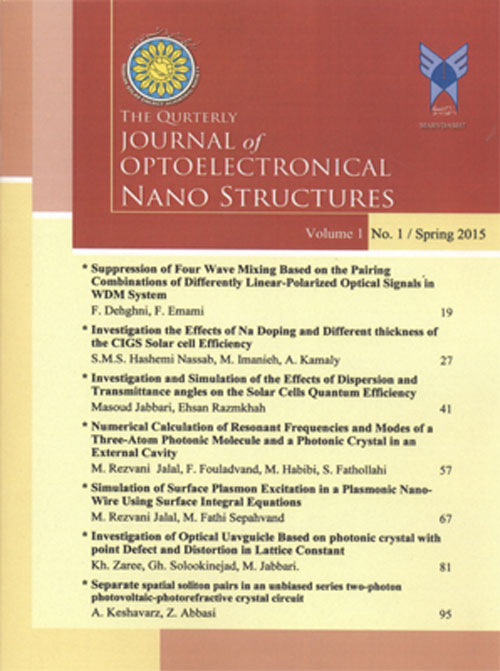فهرست مطالب

Journal of Optoelectronical Nanostructures
Volume:6 Issue: 3, Summer 2021
- تاریخ انتشار: 1400/10/07
- تعداد عناوین: 6
-
-
Pages 1-23
At a finite temperature, electron-electron interactions andenergy eigenvalues were studied using in the field ofsymplectic geometry and the relativistic radialSchrödinger equation with the expanded exponentialthermal potential (parabolic potential) representing thestrong electron-electron interaction. Electron-electroninteractions can strongly affect the effective mass, massspectrum, and functionality of multi-electron quantumdots. A quanto-relativistic interaction's behavior andeffects with temperature dependence in the magnetic fieldare shown to have a unique feature in semiconductorquantum dots. These results have important implicationsfor lighting, quantum dot enhancement film, rationaldesign, edge optic, new materials, spin electronics colorfilter, on-chip, visible and IR/NIR image sensor,photovoltaic, and fabrication of quantum dot qubits withpredictable properties.
Keywords: Energy Eigenvalues, Gaussian Asymptomatic, Relativistic Effective Mass, Schrödinger Equation -
Pages 25-41
Zig-zag Al nanostructures were fabricated on the glass and steel using thermal evaporation technique. The structural, morphology and electrical properties of Al thin films were studied by using AFM, FESEM and four-point probe instrument. FESEM analysis showed that the grains are distributed on the zig-zag Al-glass and their shape is polygonal while the grains on the zig-zag Al-steel surface have a non-uniform distribution and the shape of the grains is oval. AFM analysis indicated the surface roughness of zig-zag Al-steel nanostructures is more than the zig-zag Al-glass. Moreover, the wrinkles on the zig-zag Al-steel and the small protuberances on the zig-zag Al-glass observed. The anisotropy of electrical was performed in two perpendicular directions x and y of the samples surface. The average electrical resistivity of the zig-zag Al films on glass and steel produced were obtained about 4.69×10-8 and 5.85×10-8 Ω.m, respectively. Simulation results by the perturbation method agree with the experimental results.
Keywords: Anisotropy, Electrical characterization, Perturbation theory, Zig-zag Aluminum thin films, Perturbation Method -
Pages 43-57
Organic semiconducting polymers are for use inlow cost electronics and photovoltaic application hastechnological and scientific interest in organic materials. Inthis paper we use the time of flight of a charge packetinjected by a voltage pulse to calculate the drift velocityand mobility of holes. This technique is based on theapplication of a voltage applied at the anode andcalculating the delay time in the appearance of the injectedcarriers at the other contact. This method is a simple wayto determine the charge transport properties of the organicsemiconductors .The effect of charge trapping mechanismon the carrier mobility in the organic layers are investigatedand we discussed the theory of a electronic method toobtain the drift mobility of holes in an organic layer.Finally time of flight calculations were done on organiclayers and it was observed that the mobility reduces at lowelectric field.
Keywords: organic semiconductors, charge transport, mobility, time of flight -
Pages 59-80Nowadays conversion efficiency of photovoltaic (PV)equipment is considered as an important issue. In thisarticle, the effects of a semi-Fresnel lens as a convergentstructure will be simulated in COMSOL Multiphysicssoftware and the results would make improvements in thecharacteristic responses of PV cells which are verifiedwith our experimental results. Besides, because the grooveangles of the semi-Fresnel lens are calculated based on theorthogonal sun rays, a novel dual-axis sun tracking systemhas been designed and constructed for panel orientationadjustment. So, the sun rays always radiate at the sameefficient angles on PV cells. This issue leads to a reductionin light concentration area, the total area of the cells andtheir costs. Results show a significant improvement inoutput power of the PV cells array in comparison to theprevious study by more than 2.5 times. Also, the effectivetime of cell performance from sunrise to sunset, extendslonger during a day, regardless of location and time zone.Keywords: COMSOL Multiphysics, Semi-Fresnel Lens, Solar Cell, Sun Tracking System
-
Pages 81-92In this work, we calculated the energy levels of truncatedpyramidal-shaped InAs/GaAs QDs by using the finiteelement method by taking into account the ambienttemperature, because the system under study is notsymmetric, it is impossible to use the analytical methodto find the wave functions and energy levels of theelectron, and the finite element method is the solution tosuch problems. We showed that, with increasing thetemperature, the energy level of both the ground state andthe first excited state as well as S-to-P transitionfrequency increase. But the important point was that,increasing the temperature can shift linear and nonlinearsusceptibility graphs to higher frequencies. For example,for a pyramid with a base length of 25 nm and a height of5 nm, at zero and 500 K the maximum linear andnonlinear susceptibility values are shifted from 14terahertz to the 18 terahertz. This ability can be effectivein designing optical devices.Keywords: Quantum Dot, Linear, Nonlinear Susceptibility, Ambient Temperature
-
Pages 93-116Based on the calculations of density functional theoryand Generalized Gradient approximation (GGA),mechanical, electronic, optical and thermoelectricproperti BaFe2-xZnxAs2 (x=0,1,2) have been investigatedin orthorhombic phase. For all three BaFe2-xZnxAs2(x=0,1,2), the energy curves have an equilibrium point interms of their volume. For x=1 and x=2, the bonds takeon an ionic shape. Electronic calculations show that byapplying the modified Becke-Johonsom (mBJ)approximation, the x=2 compound is converted to a ptypesemiconductor with a gap of 0.11 eV. However,magnetic behavior can be seen for the other twoimpurities. At x=2, the band structure illustrates a directgap. Optical diagrams display that the parts of thedielectric function exhibit strong metallic behavior forimpurities x=0, 1, and also an optical gap can be detected.Moreover, the Seebeck coefficient provides that a goodstability is observed in its behavior at room temperatureonwards to reach the saturation limit of 200 μvK-1.Additionally, the figure of merit reaches a saturation limitin the range of 0.6 to 0.7 at this temperature range.Keywords: BaZn2As2, DFT, Thermoelectric properties

